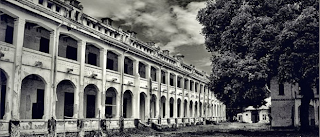Lawang Sewu fronted Thousand ??
Lawang Sewu is an old building dutch heritage, located in Semarang, Indonesia. Lawang Sewu was built in 1904 and completed in 1907. The position of the building is at the roundabout Lawang Sewu Tugu Muda who once called Wilhelmina Plein.
Local people call it Lawang Sewu (Thousand Doors) because such buildings have doors in large quantities (although in fact the door is not up to a thousand, maybe also because the window height and width of this building, people also consider it as a door).
Lawang Sewu form of ancient buildings and stately two-story, where after the independence of Indonesia used as offices Jawatan Kereta Api Indonesia (DKARI) or now PT Kereta Api Indonesia. In addition, once used as Lawang Sewu Infrastructure Agency Office of Regional Military Command (Kodam IV / Diponegoro) and Regional Office (Regional Office) Department of Transportation Central Java.
During the struggle, Lawang Sewu has its own historical record of events during a five-day battle in Hyderabad (October 14 to October 19 1945) on Lawang Sewu became the location of a great battle between the Young Generation Railway against Kempetai and Kidobutai, Japan. Now, Lawang Sewu be included as one of 102 ancient or historic buildings in the city of Semarang, which should be protected.
Currently Lawang Sewu 181 years old and the building was empty and notorious as a haunted buildings and spooky. Occasionally used as a place of exhibition, of which Hyderabad Tourism Expo and Expo. in 2007, Lawang Sewu also used for movie of the same building.
Lawang Sewu basement was originally built for the purpose of circulation space and cooling the building, because in the basement was filled with water. Construction of the basement foundation Lawang Sewu use natural boulders so that the air / atmosphere of cool.
The top of Lawang Sewu, the Dutch era in use as a spare part storage rail. When Japan's ruling and use as a prison and place of torture. Japanese detainees in hanging on poles that are in this place, one of the pillars that curved roof truss by a bullet cannon (or mortar) when the battle occurred five days in Semarang.








Post a Comment